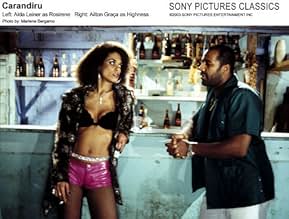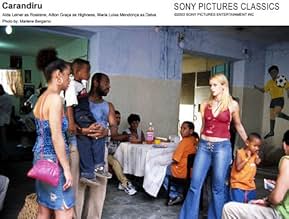El médico brasileño Drauzio Varella inicia la prevención del sida en la mayor cárcel de Brasil, Carandiru, en São Paulo, donde la población es casi el doble de la máxima.El médico brasileño Drauzio Varella inicia la prevención del sida en la mayor cárcel de Brasil, Carandiru, en São Paulo, donde la población es casi el doble de la máxima.El médico brasileño Drauzio Varella inicia la prevención del sida en la mayor cárcel de Brasil, Carandiru, en São Paulo, donde la población es casi el doble de la máxima.
- Dirección
- Guionistas
- Elenco
- Premios
- 16 premios ganados y 33 nominaciones en total
- Gilson
- (as Enrique Díaz)
- Rosirene
- (as Aída Leiner)
Opiniones destacadas
However, this is not the non-stop assault on the senses of grim violence you might expect. In fact, only the last twenty minutes or so of the film deal with the massacre at all and the film instead concentrates on a much more human aspect to the carnage. Focusing on the character of the Doctor as he tries to raise awareness of AIDs in the prison, it revolves around his day to day life as he chats casually with the inmates, learning of their hopes, fears and more often than not, their reason for being in the prison in the first place. These are stories that range from sad, to touching to outright hilarity and you soon find yourself absorbed in this world of offbeat criminals, so much so that when the violence does erupt, it is all the more shocking for it.
There are differences to the normal, US prison drama as well. I'm not sure how the Brazilians run their penitentiaries, but here there are no uniforms and they are allowed many of the comforts of home, along with free reign of the prison yard. But these are still drab conditions, with multiple inmates crammed into a single room, sweltering in the intense heat of the tropical summer. And ultimately, the prison is a community, made of genuine individuals, rather than clear cut prison stereotypes. This is a masterful film, one of my top movies of all time.
I knew this fact would be shown in Hector Babenco's film, but I could never imagine it would be so strongly illustrated. It's pure violence and the audience gets really astonished. Although it's really sad and we can't avoid being sorry for those deaths and suffering, it's impossible not to like the movie. It's excellent.
It's important to say that the invasion is not the only fact that is shown. Actually the book is based in Drauzio Varela's book. Mr. Varela is a doctor who worked in the jail helping the prisoners. The book, that is called "Estação Carandiru" (Carandiru station - because of the underground station that is nearby) is a success in Brazil.
27-year-old Rodrigo Santoro is one of the best actors we have in Brazil nowadays. His talent on Brazilian TV Series have guaranteed him good roles in films made in the country and recently he has started an international career, once he'll be in "Charlie's Angels 2". Some other good actors like Milton Gonçalves and Caio Blat add more positive points to the production. Some others, unknown up to now, showed they'll probably have much success in the future due to their talent, like Lázaro Ramos.
Argentinean Hector Babenco directed 'Carandiru' with a great sense of art, talent and made his film probably the best one of Brazilian cinema this year.
My rate 10/10
In the first place, it should be remarked that it needs a lot of courage to put on screen the beautiful and crude Varella´s book on the day-by-day of prisoners of the Sao Paulo jail Carandiru (once the biggest jail on Brazil, now demolished). In particular the movie shows one the the darkest pages in the recent Brazilian history, namely, the massacre occurred in that jail in October 1992: during a rebellion, the police invaded the prison and killed summarily 111 prisoners. Not a single policeman was even injured during the action.
In order to understand the movie, I think is very important to stress how deep has been the relevance of this sad and cruel event in the slow evolution of the Brazilian society towards less barbarian standards. At the time of the massacre most of the elites, media and middle class supported the police action and only ten years later, in 2001, some of the authors of the massacre has been put on trial. In other words the Carandiru tragic facts of 1992 and the way they have been so differently evaluated here during these years, reveals in a tragic fashion one of the most explosive contradiction of the present Brazilian society, in which a large majority of the Brazilians is completely excluded and plundered.
The movie of Babenco show this clearly and powerfully. Babenco used different kind of approaches. Most of the time the tone of the movie is realistic even bordering a documentary, but there are scenes in which the movie becomes visionary.
I am not surprise that the film was not well accepted in the recent Cannes festival. Critics from the first world are not expected to know much about the actual situation of Brazil (euphemisticly speaking). The fact is that Brazil in the USA/Europe imaginary continues to be unfortunately the country of carnival, football and samba and dark crude point of view such as the one of Babenco tend to be considered as disturbing or worst boring. So, while in the preview session for the press in Cannes 2003 most of the comments were "too long", this nearly three hours movie is one most
seen of the year in Brazil.
¿Sabías que…?
- TriviaDr. Dráuzio Varella wrote the original book at the encouragement of a patient he was treating for lymphatic cancer. That very patient happened to be Hector Babenco, who recovered and went on to direct the film adaptation.
- ErroresDuring the riot, as the inmates are running up the stairs of the cell block shortly after the riot squad has entered, one inmate can be seen wearing a T-Shirt of hip-hop group the Wu-Tang Clan. The group only formed in the year the riot took place (1992), and did not release their first widely available album (36 Chambers - Enter the Wu-Tang) until the following year. It is unlikely they would at this time have had a following in Brazil, nor would merchandise be available.
- Citas
Lady Di: I've come to take the test.
Médico - Physician: Please, take a seat. First, I'd like to ask you a few questions, Lady Di.
Lady Di: I've seen this movie before, doctor. I've never needed a blood transfusion and I never pierce my veins. The only drug I use is a joint now and then... when I watch TV or for a little romance.
Médico - Physician: And partners, how many?
Lady Di: Oh, about 2000.
- ConexionesFeatured in 2005 Glitter Awards (2005)
Selecciones populares
- How long is Carandiru?Con tecnología de Alexa
Detalles
- Fecha de lanzamiento
- Países de origen
- Sitio oficial
- Idioma
- También se conoce como
- Vzbura vo väznici Carandiru
- Locaciones de filmación
- Productoras
- Ver más créditos de la compañía en IMDbPro
Taquilla
- Presupuesto
- BRL 12,000,000 (estimado)
- Total en EE. UU. y Canadá
- USD 216,335
- Fin de semana de estreno en EE. UU. y Canadá
- USD 17,945
- 16 may 2004
- Total a nivel mundial
- USD 10,781,635
- Tiempo de ejecución2 horas 25 minutos
- Color
- Mezcla de sonido
- Relación de aspecto
- 1.85 : 1
Contribuir a esta página







































